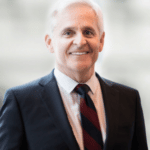
Millennium Partners’ Winthrop Center tower complied with Boston’s inclusionary development policy by partnering with the Asian Community Development Corp. on plans for a 168-unit affordable housing project. Photo courtesy of Handel Architects
What does an MIT professor of urban resources, an African American-owned cleaning company, a 100 percent affordable housing project in Chinatown and a transformational 1.4 million–square-foot tower in Downtown Boston dubbed Winthrop Center have in common? The answer: everything.
As we face the COVID-19 health threat today, the interdependency of our entire community has never been clearer and what we do with this interdependency will ultimately determine what kind of future is in store for the generations to follow. As businesspeople deeply vested in Boston, we understand that along with the opportunity to invest $1.4 billion in Winthrop Center comes the responsibility to move our city forward in ways that will not only greatly benefit the community, but also have their voices heard. What we heard was that Winthrop Center should be a market leader in sustainability, an innovator in creating affordable housing, and an ally for people of color and women to break into the different facets of the large-scale real estate industry.
Enter Professor John Fernandez, who showed us how the world’s cities are using an ever-expanding portion of the earth’s resources, with consequences for the planet and how large-scale buildings are a city’s largest consumer of these resources. Just as important, he showed us that if we provide an even healthier work environment and give people an active role in reducing their resource consumption, we could have a more effective ecosystem.
In Chinatown, we teamed up with the Asian CDC to see if we could leverage our Winthrop Center obligation to create 105 affordable housing units into more units that were both larger and available to people of lower income.
With the help of Handel Architects, we took a proven and simple residential construction and design approach from Germany that focused on sustainability and healthy air and scaled it up resulting in Winthrop Center. What is expected to be the world’s largest passive house office building, Winthrop Center will use 65 percent less energy (with an ensuing greenhouse gas emissions reduction) for heating and cooling than the typical Boston office building, while still providing 30 percent more fresh air. Upon the opening of Winthrop Center in fall 2022, passive house will be an important pathway toward a Net Zero community, and the standard for new construction in the not too distant future.
Tower Overcomes Obstacles
It all starts with talking. One of the many benefits of having the Winthrop Center project go through the gauntlet of approvals was the opportunity to forge new relationships with people across the city. One of the issues we discussed was the broad and generational obstacles that people of color and women have to overcome in order to participate in the varied career paths and professional and service business ownership opportunities that make up the real estate industry’s human infrastructure.
Those conversations went deeper, and law firms started looking into different schools to find new associates of color; architects and engineers began to team up with less experienced firms to meet diversity goals; construction unions put up billboards to attract people of color and women into their ranks; bankers started to open up their loan participation to minority-owned institutions; and DRB Facilities Services became our new cleaning service. The obstacles started to shift and the barriers began to crack. We have a long way to go, but we are building a pathway toward progress.

Joseph Larkin
In Chinatown, we teamed up with the Asian CDC to see if we could leverage our Winthrop Center obligation to create 105 affordable housing units into more units that were both larger and available to people of lower income. We targeted a rare Chinatown site owned by the city that included the Tuft Shared Services garage and a successful hotel owned by Corcoran Jennison on either side. Again, conversations started, and differences were identified and solved so that both abutters could expand into the site. Collectively we offered the city a project with all 168 affordable units, an expanded garage, a beautiful mid-market hotel and enough money to eliminate any land cost for extra units.
Despite diverse projects, diverse perspectives and diverse groups, we come together as one community because we understand that whether it’s sustainability, affordability or opportunity. Our best work is done with an open mind.
Joseph Larkin is a principal at Millennium Partners.




 |
| 
